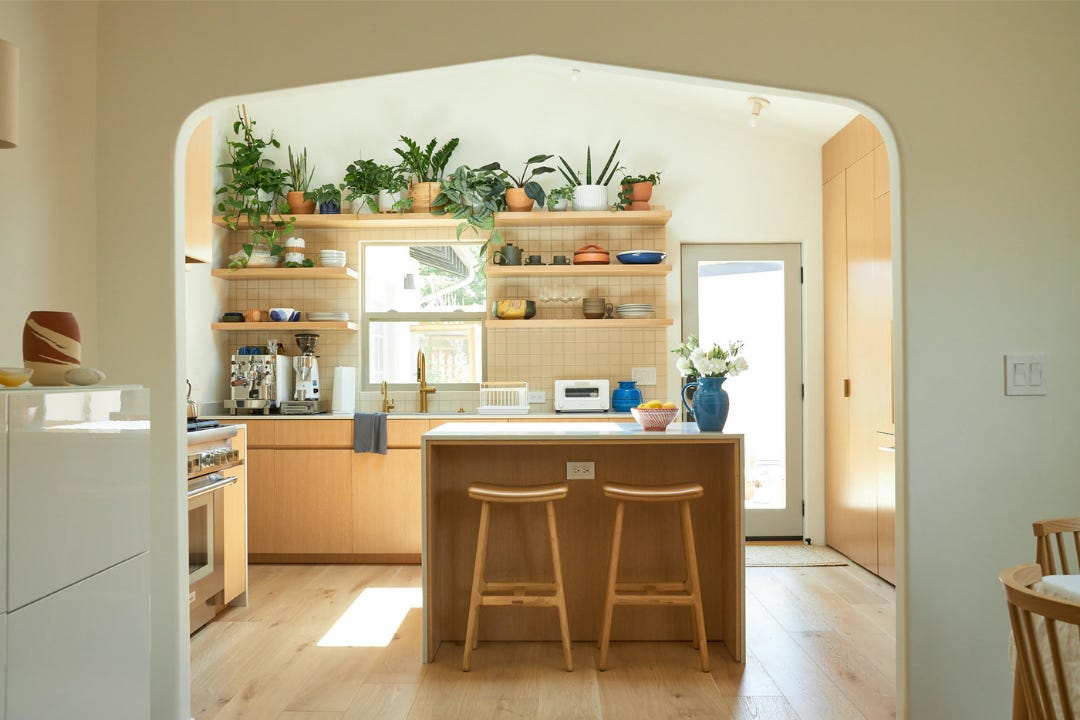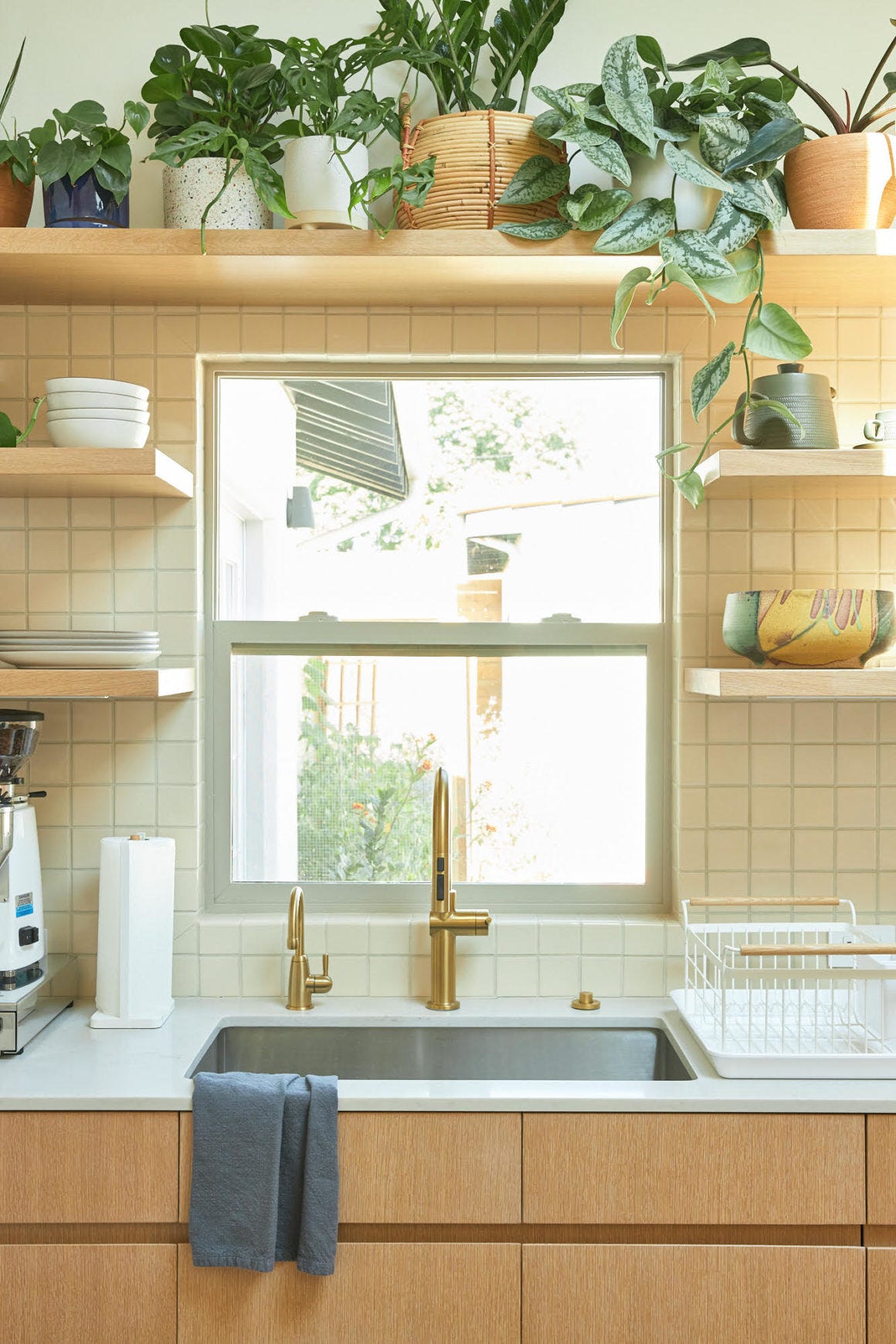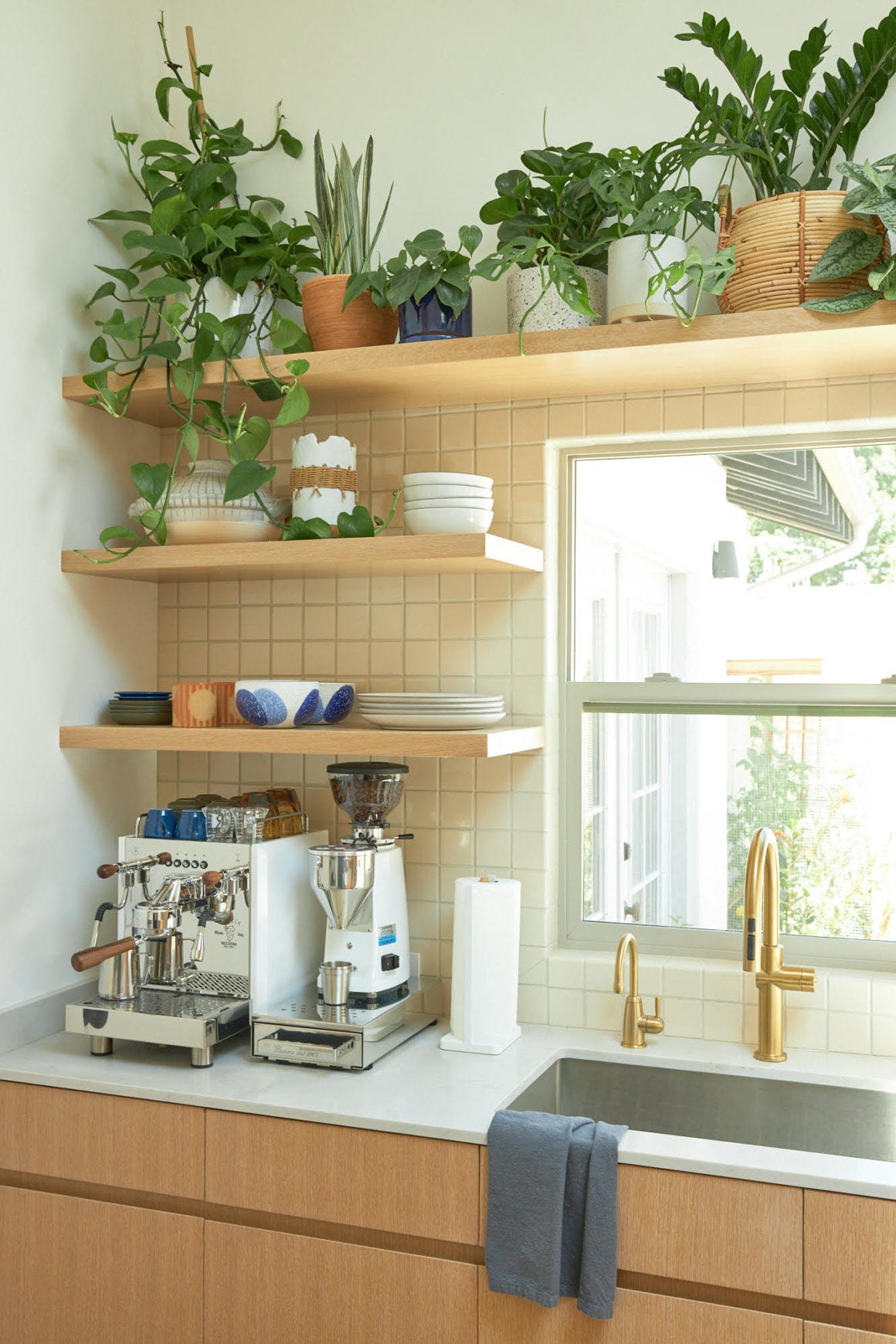We absolutely loved partnering with Danae of Folia Collective to bring some life into our newly remodeled kitchen via indoor plants. Below she is sharing so much of her knowledge on where to begin and how to keep those plants thriving once you have brought them into your home.
Whether you're looking to add just a touch of green, or a whole shelf full, adding plants to your home doesn't have to be complicated or overwhelming. Seeing your plants thrive just requires a little planning and the willingness to learn the essentials of plant care. Before you dig into bringing plants into your home or design project, ask yourself this important question and answer realistically, not just aspirationally:
-What are the constraints of my space and my lifestyle?
This question should inform your plant choices and how you use plants in your space more than anything else so we’re gonna dig a bit deeper into some of the most important factors…
LIGHT
Light is to plants as food is to humans - it's the single most important factor to consider when deciding where to place plants. Understanding the light you can offer to plants is critical if you want to see them thrive, but light terminology you may encounter on plant tags can be confusing, so here's a little breakdown of what those terms mean:
Direct Sun/Full Sun - Imagine the plants have eyes- can they see the actual sun in the sky for any part of the day? If so, that's direct sun. Direct sun in the morning is less intense, so 1-2 hours of that light is usually manageable for any plant. Direct sun in the afternoon can be much stronger, so you'll either need to select plants that can take direct sun, or filter the light with a semi-opaque white curtain or shade. You may also have a window that gets direct sun for most of the day - that's considered full sun. Best plants for direct sun: ‘Pony Tail Palm’ (Beaucarnea recurvata), Euphorbias, succulents, cacti.
Bright Indirect - This is one of the most confusing terms, but it essentially means an area where there is a wide view of the sky (so a window not blocked by a building, tree, overhang, etc), so lots of light comes through the window for at least 6 hours of the day. It can also be a window that gets direct sun, where the direct sun is filtered through something that lets light pass through like the curtain or shade mentioned above. In the northern hemisphere, a south facing window is usually the best for bright indirect light. Unless you have a skylight, this is always an area in front of a window, within the path of the light as it comes through the window - not next to, around the corner from, or across the room from a window. To benefit from this light, plants need to be within 1-3 feet of the window ideally. Best plants for bright indirect light: this is the type of light that most plants do best in.
Medium Indirect - Medium indirect is basically just that same filtered light, but further from the window (4-6 feet or so), or light coming through a window that is obstructed by a building, tree, overhang, etc. This can also apply to a north facing window, since that exposure doesn't get as bright in the northern hemisphere. There are a handful of plants that can tolerate this strength of light, but won't typically thrive in it. Best plants for medium light: ‘Chinese Evergreen’ (Aglaonema), ‘Pothos’ (Epipremnum), Peperomia obtusifolia, ferns
Low Light - It's easy to hear low light and think - a room with no windows, but the low light term still means some amount of natural light. This is a room where the windows are small, face north, or if you're placing a plant more than 6 feet from a large, bright window. There are very few plants that can tolerate this strength of light for long. If you must place a plant in a low light location, it's best to supplement with a grow light (of which there are many stylish options that look identical to regular lamps these days). Best plants for low light: ZZ plant (Zamioculcas zamiifolia), Sansevierias.
LIFESTYLE
Watering: The frequency of when you water will change depending on the type of plant you choose, so know your watering habit tendencies. If you often forget to water or travel for more than a week regularly, choose plants that can dry out completely between waterings, like Sansevierias, ZZ plant, 'Pony Tail Palm', cactus or succulent. If you’re more of a watering-every-day type, choose something that needs to be consistently moist like a fern, Calathea, Stromanthe, or Maranta
Humidity: some plants need more humidity (vapor in the air) than your space has naturally. In order for these plants to thrive, you’ll need to provide added humidity with a humidifier. Especially if you’re bothered by plant leaves that look crispy on the edges, make sure you’re ready to tackle adding humidity if you select a plant that needs it like a Calathea, Maranta, fern, Begonia, or many of the collector species of Anthurium and Alocasia.
Pets & Kids: many plants are considered ‘toxic’ if eaten, so if you have pets or small kids who are prone to taste testing your plants, you may want to select non-toxic plants to avoid any issues. Keep in mind that most plants are only a problem if consumed in large quantities, but some have sap that can be an irritant. Non-toxic plants: Spider Plant (Chlorophytum comosum), most ferns, Calatheas, Marantas, Hoyas, Aeschynanthus, most palms, Peperomias. The ASPCA has a database of plants if you want to check if the plants you have are non-toxic.
Growth Habit: When choosing a plant for a particular spot, keep in mind your traffic flow in the space, how you use the space, and who else may be in the space (back to pets and kids). Many plants can grow to be large, so look into what the plant will grow up to be when selecting. Also keep in mind that all plants will grow, so if you want a plant to stay the same size as when you buy it, you’ll need to learn some of the more complicated maintenance methods like bonsai, and root pruning.
Placement: Where you place a plant, and in what, will affect how easy it is to water, so keep this in mind too. A hanging plant will usually need to be taken down in order to water, so make sure you can reach it easily. A plant inside a pot without a drainage hole will need to be taken out to water and drain. A large tree that can’t be moved will need a deep saucer underneath so that you can bring water to it, and there is somewhere for the excess water to go. Temperature and heat/AC vents will also have an impact on plants, so make sure you aren’t placing a plant directly in front of a vent, and the room is the right temperature for the kind of plant you choose.
Now that you have a better understanding of the light and lifestyle factors important to plants, before you run to the plant shop, take the time to assess your space based not just on where plants will look best, but where they will be able to thrive. As you assess your space, remember to be realistic, not aspirational - if you have blinds but never actually open them, don’t judge the light in that room with the blinds open. Take stock of the light at various points in the day as well, so you have the full picture. Think through how you actually use the rooms you want to add plants to, and consider all the lifestyle factors above.
PLANT PLAN
With that assessment in mind, make a plant plan:
For each area you want to put a plant, make a note of the kind of light, the dimensions of the space you’d like the plant to fill, and any shape constraints (tall and skinny, low and bushy, etc). Take photos if you hope to have someone at the store help you.
If you already have planters you want to use, measure the inside of them and make a note (keeping that info with the info about the space you plan to use the planter in). Note - most indoor plants are sold by the diameter of the pot they are in and those sizes are relatively standard, so make sure you have the diameter of the planter, and be prepared that there may not be a plant that is the exact size of the planter.
Be open to options. You may see a plant on Pinterest that you love, but it might not be a plant that is right for your space, easily available, or in stock in your area. Having a general idea of the shape or type of plant is better than having your heart set on only one specific plant.
Choose a shop with healthy plants and knowledgeable staff. Many big box stores sell plants, but they are often not well cared for there, and the staff usually don’t specialize in indoor plants. If you know you’ll have questions, or aren’t practiced in how to choose a healthy plant, opt for a nursery or plant shop, where the staff is often better trained, and the plants are looked after.
Now that you have a plan, you can head to the shops and pick out your plants! If you're still feeling uncertain about adding plants to your life, here are a few options to get you started, that most people find to be easy to care for:
Philodendron hederaceum aka 'Heart Leaf Philodendron’ : This trailing or climbing beauty with green heart shaped leaves does best in bright filtered light, but can tolerate medium too. Water when the top 1/3 of the soil has dried out.
Sansevieria species (recently reclassified to Dracaena) : With over 60+ options, Sansevierias offer a wide range of shapes and colors to choose from. These hearty plants can tolerate lower light and should be watered when the soil has dried all the way to the bottom of the pot.
Epipremnum aureum aka ‘Pothos' : A classic, this is another plant that can trail or down, or climb when given some support. Does best in bright filtered light, but will tolerate medium light. Water when the top 1/3 of the soil has dried out (watch for tell-tale softer, droopier leaves as a sign the soil has gone a little too dry).
Zamioculcas zamiifolia aka 'ZZ Plant’ : With its sculptural shape and glossy, vibrant leaves, it's almost hard to believe this plant is 'low maintenance'! As with most plants, bright filtered light is best, but ZZ plants will tolerate lower light as well. Water when the soil has dried out all the way to the bottom.
Peperomia obtusifolia aka 'Baby Rubber Plant'. Cute rounded leaves are the hallmark of this hearty species of Peperomia. Bright filtered light is optimal, but will tolerate medium light. Water when the soil is dry about 3/4 of the way down.
Photography by Andre Vippolis







